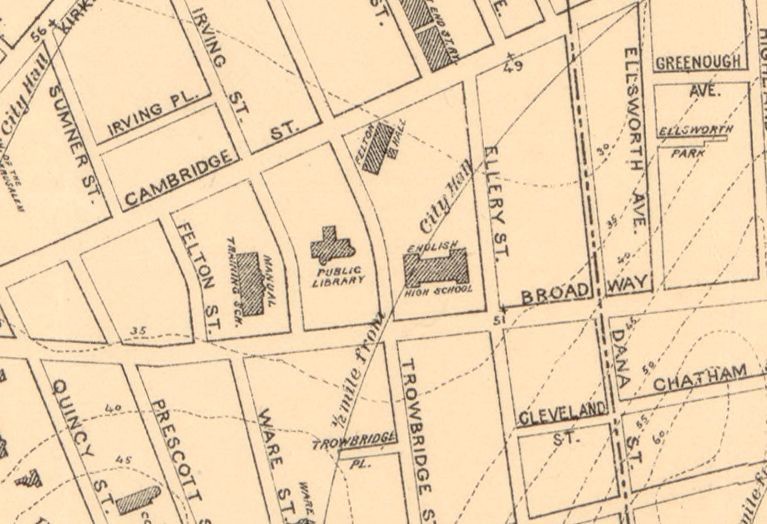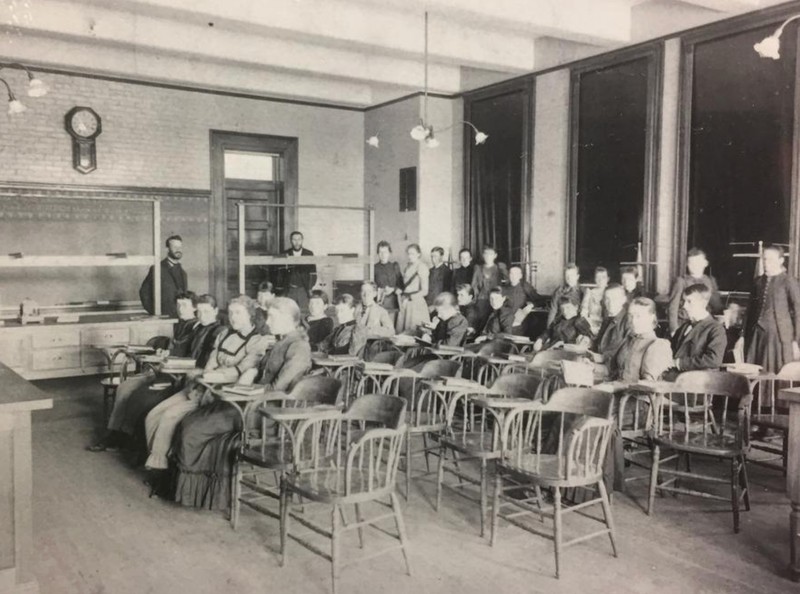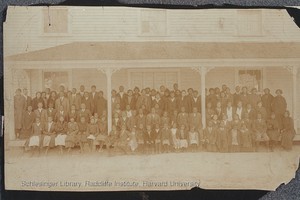Charlotte Hawkins Brown - Cambridge English High School
Introduction
Text-to-speech Audio
Charlotte Hawkins Brown (1883-1961) was the founder of the Palmer Memorial Institute, a prestigious boarding school for Black students in North Carolina. Though Brown spent most of her adult life outside of Cambridge, she maintained connections to Cambridge and Boston throughout her life, many of which she began to develop in her high school years at Cambridge English High School, which stood at this site. Brown’s alma mater, often referred to as “English,” was one of three Cambridge public high schools. English, along with The Cambridge Latin School and the Rindge Manual Training School shared this tract of land with Cambridge’s Public Library, which still stands today. By 1977, the three schools had merged to form the Cambridge Rindge and Latin School, which sits across the street from the Cambridge Public Library. A love of language, visual arts, and other subjects informed Brown’s work as a holistic educator who empowered students to be full people and make change in the world.
Images
Dr. Brown with a bust of Alice Freeman Palmer

Map of Old Cambridge

A Science Class at Cambridge English High School

Students & Faculty at the Palmer Memorial Institute

Backstory and Context
Text-to-speech Audio
Charlotte Hawkins Brown was born June 11, 1883 in Henderson, North Carolina. Her mother moved her family to Cambridge in 1888 to escape discrimination in the South. Brown attended the Allston Grammar School, where she was chosen as graduation speaker, before attending Cambridge English High School. Brown showed an early aptitude for educational leadership. At twelve, she started a Sunday School department for kindergarten students at the predominantly Black Union Baptist Church in Cambridge, MA. Alberta V. Scott, the first Black graduate of Radcliffe College and another woman featured on this walking tour, was also a member of the Union Baptist Church.
During Brown’s senior year, one of her teachers helped her find a job babysitting, where, one day, she met Alice Palmer Walker, the first president of Wellesley College. Walker wrote to the principal of English, intrigued by Brown, who had in one hand a stroller and in another a copy of the book Virgil. Brown herself then reached out to Walker, who helped pay her tuition at State Normal School at Salem, now Salem State University. In 1901, prior to her graduation, Brown went to Sedalia, North Carolina to teach Black students with the American Missionary Association. The AMA closed the school in 1902, prompting Brown to establish her own school which she named the Palmer Memorial Institute, in honor of Palmer who had died later that year.
The Palmer Memorial Institute began as a small, underfunded rural school, but Brown’s fundraising campaigns, comprehensive curriculum, hardworking students, and dedicated staff (the painter Louis Mailou Jones founded Palmer’s art department) transformed the school into an elite coeducational Black preparatory boarding school that educated thousands of students in the sixty-nine years the school was open. The school educated tons of students from influential Black families, including singer Maria King Cole. While Brown’s early curriculum featured manual and agricultural work, the institute eventually adopted a more liberal arts education. Brown’s school prepare students for college and offered courses in drama, math, literature, art, and science, affording Black students rich educational opportunities often only available to white students.
During her time as principal, Brown often returned to Massachusetts to speak at educational institutions and to raise funds for her school, tapping into Palmer’s and her own social networks. She spoke at educational institutions (including Smith, Mount Holyoke, Radcliffe, and Wellesley), conventions, and cultural sites about Black women’s role in America, the necessity of education, her own relationship with America, and more. In a 1909 speech at Union Baptist Church, Brown praised Black Cambridge educator Maria Baldwin’s work at the Agassiz school. Brown also helped organize the Sedalia Club, a fundraising and support group run by Cambridge and Brookline women.
The Palmer Memorial Institute’s philosophy was "Educate the individual to live in the greater world."2 Students would go on to become government officials, actors, lawyers, teachers, writers, and more. Brown further impacted the world through her writing and activism. She was involved in the National Council of Negro Women, National Association of Colored Women, and more, mobilizing other women through political and social clubs.
Sources
1. Burns, A.M. “Charlotte Hawkins Brown.” NCPedia, https://www.ncpedia.org/biography/brown-charlotte-hawkins0
2. “Dr. Charlotte Hawkins Brown.” historicsites.nc.gov, https://historicsites.nc.gov/all-sites/charlotte-hawkins-brown-museum/history/dr-charlotte-hawkins-brown
3. “Entertainment in Aid of Palmer Memorial Institute.” The Boston Globe, 22 Oct. 1921.
4. Espirito, Allison. “Charlotte Hawkins Brown. Blackpast, https://www.Blackpast.org/african-american-history/brown-charlotte-eugenia-hawkins-1883-1961/.
5. Hawkins Brown, Charlotte. "Some Incidents in the Life and Career of Charlotte Hawkins Brown Growing out of Racial Situations, at the Request of Dr. Ralph Bunche." Series I. Schlesinger Library, Harvard University. Web. https://hollisarchives.lib.harvard.edu/repositories/8/archival_objects/1425691
6. Hawkins Brown, Charlotte. "A Biography." Series I. Schlesinger Library, Harvard University. Web. https://hollisarchives.lib.harvard.edu/repositories/8/archival_objects/1425690
7. Jones, Maxine D. “Charlotte Hawkins Brown and Palmer Memorial Institute: What One Young African American Woman Could Do by Charles W. Wadelington and Richard F. Knapp.” The Journal of Southern History, 67, no. 3 (Aug., 2001): 684-685.
8. “Leaves $800,000 to Her Daughter: Will of Mme. Walker Makes Girl Richest Negress in America.” Fall River Daily Evening News, 13 June 1919.
9. Fitchburg Sentinel. 11 April 1928: 2
10. “Reception by Sedalia Club.” The Boston Globe, 30 March 1915.
11. “Sedalia Club Has Entertainment and Sale.” The Boston Globe, 25 April 1918.
12. Smith, Sandra N. “Charlotte Hawkins Brown”, The Journal of Negro Education: An Historical Overview (Summer, 1982), pp. 191-206
13. “Tells of Work in The South.” The Boston Globe, 24 Sept. 1909.
14. “Winchester.” The Boston Globe. 24 April 1919.
https://digital.ncdcr.gov/digital/collection/p16062coll13/id/78
https://www.loc.gov/resource/g3764c.ct006024/?r=0.479,0.199,0.105,0.068,0
https://cambridge.wickedlocal.com/photogallery/WL/20190823/NEWS/831009998/PH/1
http://id.lib.harvard.edu/via/olvgroup1002419/catalog
